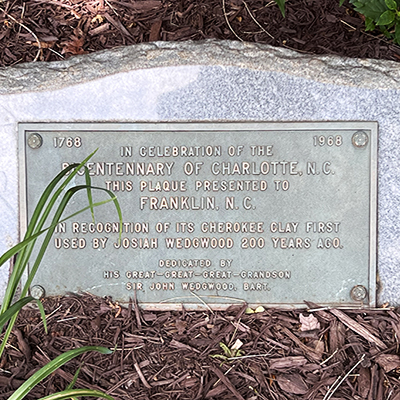
Cherokee Clay, Franklin
The Cherokee Clay marker is a rectangular bronze plaque attached to a small lectern shaped granite block with a low serpentine top.
Images:
Far-off view of the memorial marker
1768 1968 / IN CELEBRATION OF THE / BICENTENARY OF CHARLOTTE, N.C. / THIS PLAQUE PRESENTED TO / FRANKLIN, N.C. / IN RECOGNITION OF ITS CHEROKEE CLAY FIRST / USED BY JOSIAH WEDGEWOOD 200 YEARS AGO. / DEDICATED BY / HIS GREAT-GREAT-GREAT GRANDSON / SIR JOHN WEDGEWOOD, BART.
April 22, 1968
"'Cherokee Clay’ and Wedgewood Pottery,” North Carolina Department of Cultural and Natural Resources, December 18, 2016, (accessed August 1, 2023) Link
Anderson, William L., 2006. Cherokee Clay NCpedia, (accessed August 1, 2023) Link
Bouknight, Deena C. “Wedgewood’s Quest for Kaolin Puts Macon on Global Map in 18th Century,” Macon County News (Franklin, NC), February 8, 2019, (accessed August 1, 2023) Link
Ellison, George. "Region’s Kaolin History Is Nearly Forgotten," Smoky Mountain News (Waynesville, NC), October 20, 2023, (accessed August 3, 2023) Link
Wedgwood, Hensleigh C. "A Mission for Mr. Wedgwood," American Heritage 21.5. (August, 1970) (accessed August 3, 2023) Link
“Pottery Traditions: Wedgewood Clay Historical Marker,” Hunter Library, Western Carolina University, (accessed August 1, 2023) Link
“Wedgewood Plaque Goes to Franklin,” Greensboro Daily News (Greensboro, NC), April 23, 1968
Yes
Granite, bronze
Sir John Wedgewood
Sir John Wedgewood, great-great grandson of Josiah Wedgewood, dedicated the memorial.
By the 1740’s potters in England and across the colonies had learned that white clay deposits containing kaolin and petunze, essential ingredients for porcelain, existed in Cherokee controlled regions of the North Carolina mountains. In 1767, after a failed earlier attempt to get samples of the clay, English potter Josiah Wedgewood commissioned Thomas Griffiths to travel to the colonies to obtain some of the “Cherokee Clay.” Landing in Charleston, South Carolina, Griffiths then traveled to what is now Macon County in a time when there were essentially no roads and few towns. Griffiths succeeded in returning to London in 1768 with five tons of the clay. This supply lasted until 1783 by which time suitable clay had been found in England. Griffith’s account of his journey, “Cherokee Clay, from Duché to Wedgwood: The Journal of Thomas Griffiths, 1767-1768,” recounts the arduous task it was to obtain the clay. He describes his negotiation with the Cherokee and digging for the clay: “Here we labourd hard for 3 days in Clearing away the rubish out of the old pitt, which could not be less than Twelve or fifteen Ton; but on the fourth day, when the pitt was well cleand out, and the Clay appeard fine; to my great surprise, the Chief Men of Ayoree came and Took me prisoner, telling me I was a Tresspaser on their land and that they had reed instructions from Fort George, not to suffer their pitt to be opened on any account; and as to any consent of the head men of the Nation, they minded not, nor would they let any clay be dug under five hundred weight of Leather for every Ton: they also showd me a string of white Beads that the Young Warier had brought from the fort, as a firm Token of a faithfull and True Talk—This was a Mistake of some of the Gentle’n at fort George, which confounded me greatly, and I never yet had it cleard up; and have great reason to think there was some deceipt at the bottom; and proved of very ill Consequence to me, as it made the Indians set a high Value on their white Earth: however I sent for a Linguist and after a Strong Talk which lasted near four hours, we settld matters on such conditions, as I might obtain what I wanted without any further Molestation …”
The monument is located in Rankin Square at the intersection of West Main Street (Business U.S. 441) and Phillips Street, on the left when traveling west on West Main Street in Franklin, NC. The Macon County Confederate Monument can also be found in Rankin Square. The William Bartram Marker is across the intersection on the opposite corner at the Franklin Town Square. At the sidewalk facing Phillips Street is a state highway historical marker for the Battle of Echo, Marker: QQ-1. At the Macon County Courthouse across the street is a Charters of Freedom memorial similar to those at many courthouses across the state. Examples of Charters of Freedom can be found in Buncombe and Burke counties.
The memorial marker sits on a beautifully landscaped by a brick paver walkway lined with landscaped plants
 Know anything else about this monument that isn't mentioned here? If you have additional information on
this or any other monument in our collection fill out the form at the Contact Us link in the footer. Thank you.
Know anything else about this monument that isn't mentioned here? If you have additional information on
this or any other monument in our collection fill out the form at the Contact Us link in the footer. Thank you.

